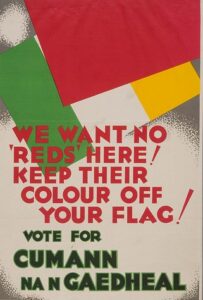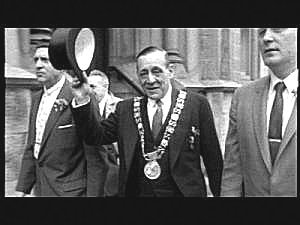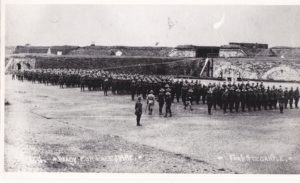Podcast: The Irish Revolution, the ‘Jewish Question’ and Antisemitism, with Brian Hanley

John Dorney and Cathal Brennan discuss the Irish and Jewish ‘Questions’ in the interwar period with Brian Hanley. First Broadcast on The Irish History Show.
At the time of the ‘Irish Revolution’ 1916-1923, two of the many ‘national questions’ that exercised international statesmen were ‘the Irish question’ and the ‘Jewish question’. The first ‘question’ was how to satisfy Irish demands for self government. The second was the more amorphous task of how to integrate Jewish communities into the new world of nation states. Should they be integrated into other nations, hold autonomy within them or, still a minority opinion, at that time, form their own nation state? This was the dream of the still nascent Zionist movement, which had been promised a ‘national home’ in Palestine by the British in 1917.
Aidan Beatty has noted that the stories of Irish and Jewish nationalism have been ‘oddly intertwined‘ at times. In the post 1918 era, as Brian Hanley writes, some thought, ‘the Irish and the Jews have a good deal in common’. Both were denied access to the ‘national self determination’ promised at the Paris Peace Conference. Both also had large ‘diaspora’ communities that lobbied on their behalf, especially in the United States.
Among Ireland’s small Jewish community, there were some notable examples of Irish Republican activists including Bob Briscoe, who acted as a gun runner for the IRA between 1919 and 1923 and Michael Noyk, a lawyer, who represented Republican suspects and sat on Dail Courts. Some thought that the Irish and Jewish cases were equivalent – Briscoe in particular being an ardent Zionist as well as an Irish separatist.
The Irish and Jewish ‘Questions’ were sometimes seen as parallel movements for national self determination in the interwar years.
The two cases had, in some respects, however, marked differences. Irish nationalists lived on a (more or less, allowing for the contested north of the island) well defined ancestral territory that lobbied for self-rule, or laterally independence, from Britain. Jews in Europe – Ashkenazi or western Jews – lived principally in shtetl communities in eastern and central Europe. While they were also united by common culture and language – Yiddish – they varied by country, by politics, by degree of religious observance and by degree of integration into wider society.
It was not clear to all if they were a ‘national’ group or an ethnic and religious minority.
Jewish self-determination, for those who demanded it, could mean many different things. To the Zionist movement it meant establishing a Jewish homeland in Palestine, but for others, such as the socialist Bund movement it could mean Jewish self-rule in the empires and nation states in which they found themselves. Interestingly also, while Zionists advocated the revival of Hebrew as a secular language of the Jewish people, the Bundists saw Yiddish as being central to modern Jewish identity.
Elsewhere, among the large Jewish immigrant communities in western Europe and the United States (including a small immigrant community in Ireland), the predominant sympathy was not for the self-determination of their community, but for tolerance, equality before the law and, in the case of all but the most religious, assimilation into the host society. Many working class Jews of the era, both in eastern Europe and in the west, were attracted to socialism or communism, with its promise of absolute equality for all, without social or ethnic distinction.
This in turn led to European nationalists of the far right (of whom the National Socialists in Germany were only one example) often depicting communism as a ‘Jewish plot’, merely pretending to care about the welfare of the working classes and in fact in league with ‘international finance capital’ also, supposedly, controlled by the nefarious Jews, in order to undermine their European nation states.
Thus, Antisemitism in the post-First World War world could sometimes mean hostility to actual Jewish communities, but it could also be a more abstract set of beliefs that identified Jewish influence with the decline of the traditional moral order, the dilution of national identity, class conflict and ascribing almost any setbacks, from Germany’s defeat in the First World War to hyper-inflation and unemployment, to unseen Jewish influence.
All of these conceptions of ‘the Jewish question’ and antisemitism, played, as we discuss below with Brian Hanley, a surprisingly large role in the discourse around the Irish revolution.

Some Irish nationalists such as Michael Davitt were openly sympathetic to the Zionist cause. Others, such as Arthur Griffith have been accused of antisemitism. Jews in Limerick were subjected to a boycott in Limerick 1904 as a result of their alleged involvement in money-lending.
Some British imperialist voices were, during the War of Independence, adamant that the ‘Irish rebellion’ was in some way the product of the international Jewish-linked communist conspiracy, aimed at breaking up the British Empire. While Irish nationalists could, in most cases simply laugh this off, antisemitism also popped up at strange moments in their ranks too.
After the Treaty split and during the Civil War, some pro-Treaty figures suggested that anti-Treaty leader Eamon de Valera, whom they blamed for the internecine conflict, was of Jewish origin. The rupture of the national movement was it seems, so painful and difficult to understand that some had to reach for an outside conspiracy to explain it. In fact, the two most prominent Jewish activists in the Republican movement – Bob Briscoe and Michael Noyk – were evenly divided on the Treaty, the former anti and the latter pro.
Anti-communism could sometimes be fused with antisemitism in the 1920s and 30s, even in Ireland where there were few Jews or communists.
Nevertheless, the rhetoric of antisemitism seeped to some extent into the pro-Treaty political tradition in the 1920s and 30s, especially in the uniformed Blueshirt movement – a movement that aped the style, if not entirely the substance, of interwar fascist movements. As Brian Hanley notes there was an odd but widespread assertion that anti-Treaty Republicans in the anti-Treaty IRA and the early Fianna Fail, were not Irish nationalists at all, but communists and in some way led by Jews.
There was also a rather sinister case of two killings of Jewish civilians in Dublin by pro-Treaty National Army officers in 1923, apparently on a personal vendetta. One of the alleged culprits, James Conroy (a former Squad member) was also a Blueshirt in later years.
The anti-Treatyites had their conspiracy theories also, their enemies were often labelled ‘imperialists and freemasons’ for example, and former unionists ‘the enemy civilian garrison’ which had a hint of anti-Protestant sectarian rancour about it. There was also an IRA campaign against money lenders in Dublin in 1926 that was alleged to have had overtones of antisemitism.
But antisemitism does not seem to have played a significant role in Republican discourse until a rump faction of the IRA looked to Nazi Germany for aid during the Second World War and War News, the Republican newspaper carried a number of antisemitic articles.
While the Irish Jewish community was very small and not at all influential in politics, as Brian Hanley notes in the discussion below, what this shows is that antisemitism does not in fact even need the presence of Jews to make itself heard. Rather it often functions as a conspiracy theory, a simplistic attempt to put order on a confusing and at times frightening reality.

Post 1945, international events, including the Holocaust and the establishment of the state of Israel 1948, very much changed the context of how ‘the Jewish question’ was discussed in Ireland, as elsewhere.
Much of the Jewish community of east and central Europe was wiped out and many of those who survived emigrated. This tragedy largely ended the ‘Jewish question’ as it had been understood in the interwar years.
In the Soviet Union, Stalin’s own antisemitism to a significant degree eroded the supposed connection between Jews and communism in the public mind.
In Palestine the ‘revisionist’ Zionists (that is those in favour of armed struggle to remove the British presence from Palestine) identified to some degree with Irish Republican methods and objectives. At the time this admiration was partly reciprocated, especially since many of the British police in Palestine were former Black and Tans and Auxiliaries. But in later decades, especially after the 1967 war, and the Israeli occupation of the West Bank and Gaza Irish republican opinion swung instead towards support for the Palestinian struggle against Israel. But this is a discussion for another day.
The podcast is below: